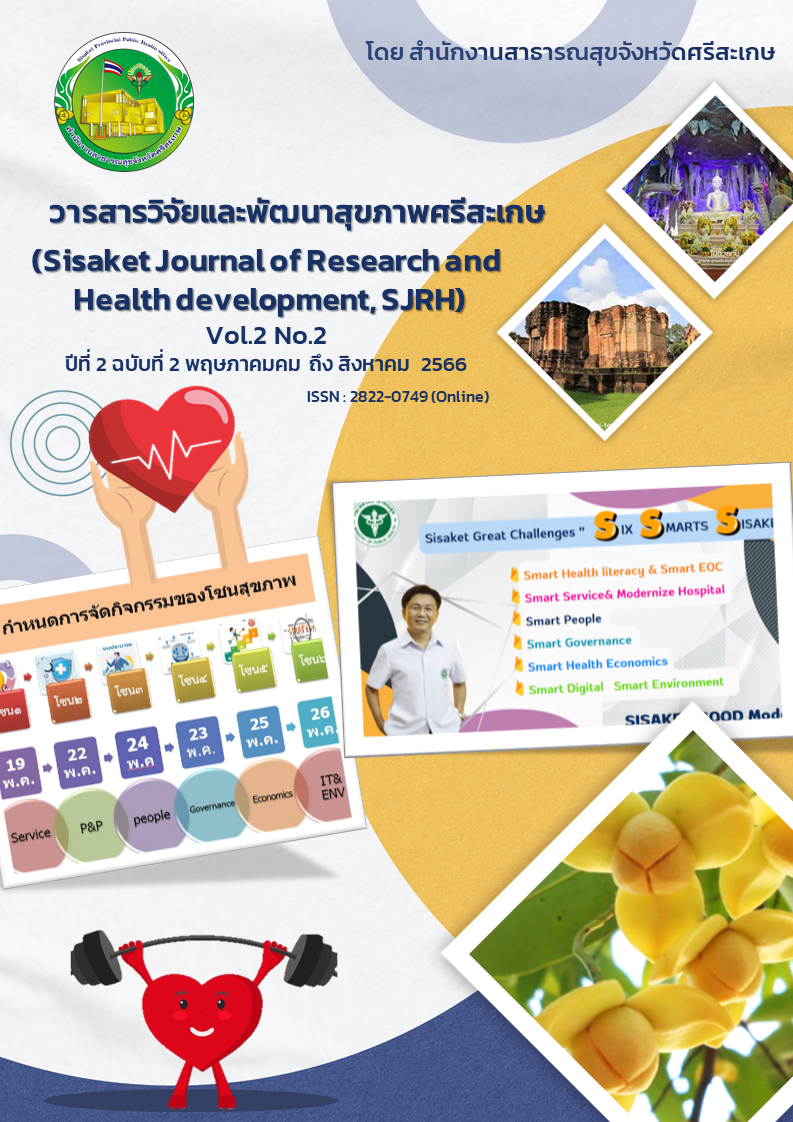การพยาบาลผู้ป่วยโรคหัวใจขาดเลือดเฉียบพลันชนิดเอสทียกสูง (ST-Elevated Myocardia Infraction ) โดยใช้แนวคิดการให้ครอบครัวมีส่วนร่วมเป็นสักขีพยานในการช่วยฟื้นคืนชีพ (family-Witnessed Resuscitation, FWR) : กรณีศึกษา
Main Article Content
บทคัดย่อ
การศึกษารายกรณีนี้มีวัตถุประสงค์เพื่อศึกษาพยาธิสภาพของโรคและวิเคราะห์กระบวนการให้การพยาบาล โดยใช้บทบาทผู้ปฏิบัติการพยาบาลขั้นสูงในการพยาบาลผู้ป่วยโรคหัวใจขาดเลือดเฉียบพลันชนิดเอสทียกสูง(ST-Elevated Myocardia Infraction) ร่วมกับใช้แนวคิดการให้ครอบครัวมีส่วนร่วมเป็นสักขีพยานในการช่วยฟื้นคืนชีพ เครื่องมือที่ใช้ในการศึกษาประกอบด้วย แบบรวบรวมข้อมูลจากเวชระเบียนและแบบสัมภาษณ์ผู้ป่วย สามารถระบุปัญหาพยาบาลในระยะวิกฤต ขณะเข้ารับการรักษา ณ แผนกอุบัติเหตุฉุกเฉินและนิติเวชได้ดังนี้ 1) เจ็บหน้าอกรุนแรงเนื่องจากภาวะหัวใจขาดเลือดเฉียบพลัน 2) เสี่ยงต่อการเกิดภาวะเนื้อเยื่อพร่องออกซิเจนเนื่องจากปริมาณเลือดออกจากหัวใจใน 1 นาทีลดลง 3) มีโอกาสเกิดผลกระทบจากการได้รับยาละลายลิ่มเลือด 4) เสี่ยงต่อการเกิดภาวะแทรกซ้อนขณะส่งต่อ (Adverse event) เช่น หัวใจหยุดเต้น, Cardiogenic shock ซ้ำ และ 5) ผู้ป่วยและครอบครัวมีความวิตกกังวล กลัวเกี่ยวกับพยาธิสภาพของโรคและแผนการรักษา พบว่าการให้การพยาบาลบรรลุตามวัตถุประสงค์เป็นส่วนใหญ่ ขณะเดียวกันพบว่าการฟื้นฟูสภาพภายหลังการรักษาในระยะวิกฤต ซึ่งมีความสำคัญในการสร้างความเข้าใจในการดูแลตนเอง พยาบาลจะต้องส่งเสริมการดูแลตนเองทั้งด้านการสังเกตอาการผิดปกติหรือภาวะแทรกซ้อนที่เกิดขึ้น การเฝ้าระวังการเกิดอาการข้างเคียงจากการใช้ยาละลายลิ่มเลือดการส่งเสริมการเข้ารับการรักษาที่ต่อเนื่อง เพื่อหลีกเลี่ยงการกลับเป็นซ้ำและให้ผู้ป่วยสามารถใช้ชีวิตอยู่กับการเจ็บป่วยได้อย่างเหมาะสม ผู้ปฏิบัติการพยาบาลขั้นสูงที่ปฏิบัติงานในแผนกอุบัติเหตุฉุกเฉินและนิติเวช เป็นบุคคลสำคัญและมีความเชี่ยวชาญทางคลินิกคือการให้คำปรึกษา การชี้แนะ สนับสนุนและเป็นผู้นำทีมพยาบาลในการจัดการกับปัญหาที่ซับซ้อนและต้องการการบริการที่เฉพาะ ต้องอาศัยความเชี่ยวชาญเพื่อปรับปรุงคุณภาพของการบริการและส่งเสริมการใช้หลักฐานเชิงประจักษ์การดูแลผู้ป่วยที่ซับซ้อน เพื่อปรับปรุงคุณภาพการพยาบาลและผลลัพธ์ของการบริการที่ดีขึ้น
Article Details

อนุญาตภายใต้เงื่อนไข Creative Commons Attribution-NonCommercial-NoDerivatives 4.0 International License.
เนื้อหาและข้อมูล (เขียนข้อกำหนด)
เอกสารอ้างอิง
เฉลิมศรี สุวรรณเจดีย์.(2553). คู่มือการพยาบาลโรคหัวใจ. พิมพ์ครั้งที่ 6 บ.พิธการพิมพ์
Afzali Rubin, M., Svensson, T., Herling, S. F., Wirenfeldt Klausen, T., Jabre, P., & Møller, A. M. (2020). Family presence during resuscitation. The Cochrane Database of Systematic Reviews, 2020(5), CD013619.
Bobadilla RV.(2016). Acute coronary syndrome: focus on antiplatelet therapy. Crit Care Nurse. 36(1), 15 -17
Bérubé, M., Bernard, F., Marton, H., Parent, J., Thibault, M., Williamson, D. R. et al. (2013). Impact of a preventive programme on the occurrence of Incidents during the transport of critically ill patients. Intensive and Critical Care Nursing. 29(1), 9-19
Barreto, M., Peruzzo, H. E., Garcia-Vivar, C., & Marcon, S. S. (2019). Family presence during cardiopulmonary resuscitation and invasive procedures: a meta-synthesis. Revista da Escola de Enfermagem da U S P, 53, e03435.
Cathy Grimen. 2020. The effects of family-witnessed resuscitation on health professionals. British Journal of Nursing. 29(15), 892-896
DeVon, H. A., Mirzaei, S., & Zègre-Hemsey, J. (2020). Typical and Atypical Symptoms of Acute Coronary Syndrome: Time to Retire the Terms?. Journal of the American Heart Association, 9(7), e015539
De Stefano, C., Normand, D., Jabre, P., Azoulay, E., Kentish-Barnes, N., Lapostolle, F., Baubet, T., Reuter, P. G., Javaud, N., Borron, S. W., Vicaut, E., & Adnet, F. (2016). Family Presence during Resuscitation: A Qualitative Analysis from a National Multicenter Randomized Clinical Trial. PloS one, 11(6)
Giannitsis, E., Kurz, K., Hallermayer, K., Jarausch, J., Jaffe, A. S., & Katus, H. A. (2010). Analytical validation of a high-sensitivity cardiac troponin T assay. Clinical chemistry, 56(2), 254–261.
Hanson C & Strawser D (1992). Family presence during cardiopulmonary resuscitation: Foote Hospital emergency department's nine-year perspective. Journal of Emergency Nursing, 18, 104-106
Jia H, Abtahian F, Aguirre AD, Lee S, Chia S, Lowe H, et al. (2013). In vivo diagnosis of plaque erosion and calcified nodule in patients with acute coronary syndrome by intravascular optical coherence tomography. J Am Coll Cardiol.62(17), 48-58
Khan, S. S., Ning, H., Sinha, A., Wilkins, J., Allen, N. B., Vu, T. H. T., Berry, J. D., Lloyd-Jones, D. M., & Sweis, R. (2021). Cigarette smoking and competing risks for fatal and nonfatal cardiovascular disease subtypes across the life course. Journal of the American Heart Association, 10(23), [e021751].
Kue, R., brown, P., Nremt-p., Ness, C., & Scheulen, J.(2011). Adverse clinical events during Intra-hospital transport by a specialized team: a preliminary report. American Journal of Critical Care. 20(2), 153-162
Ibanez B, James S, Agewall S, et al. (2017).ESC Guidelines for the management of acute myocardial infarction in patients presenting with ST-segment elevation: The Task Force for the management of acute myocardial infarction in patients presenting with ST-segment elevation of the European Society of Cardiology (ESC). Eur Heart J 2018;39(2): 119-177
Ministry of Public Health.(2020). Twenty-year national strategic plan for public health: 2017-2036. [Cited 2022, jan 8]. Available from: http://164.115.27.97/digital/files/ original/2ddc0ac1ececa4c666af70165c23e011.pdf.
Tang EW, Wong C, Herbison P.(2007) .Global Registry of Acute Coronary Events (GRACE)hospital discharge risk score accurately predicts long-term mortality post acute coronary syndrome. Am Heart J. 153, 29-35.
Urden, L. D., Staey, K. M., & Lough, M. E. (2008). Critical care nursing (5th ed.). Missouri, United Stated, Elsevies Mosby.
Vardanjani, A. E., Golitaleb, M., Abdi, K., Kia, M. K., Moayedi, S., Torres, M., & Dehghan-Nayeri, N. (2021). The Effect of Family Presence During Resuscitation and Invasive Procedures on Patients and Families: An Umbrella Review. Journal of emergency nursing, 47(5), 752–760
World Health Organization.(2020). Cardiovascular disease ( CVDs). [ Cited 2021, Nov 8]. Available from: https://www.who.int/news-room/fact-sheets/detail/ cardiovascular-diseases-(cvds).
Wongnaikot, P., & Saensom, D. (2017).Development of an intrahospital transfer clinical nursing practice guideline for critically ill trauma patients.The National and International Graduate Research Conference 2016, Khon Kaen University, Khon Kaen.ภาคผนวก ภาพประกอบกรณีศึกษา


